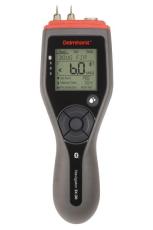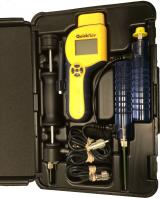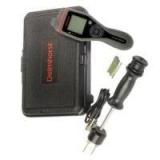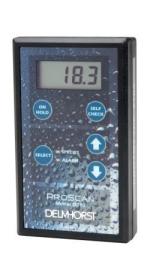
FAQs about moisture measurementRestoration moisture meters - questions & answers |
|
Why should I use a moisture meter for a water-damaged structure? The only way to be sure you are properly drying a structure after water damage is to monitor the drying process with a moisture meter. Even if you have the most advanced drying equipment, you cannot be sure they are working effectively without the use of a moisture meter. How does a moisture meter work? There are two types of moisture meters typically used in the restoration industry. Pin-type meters, which utilize the principle of electrical resistance, use wood or other hygroscopic materials as an element in a circuit by driving two pins or electrodes into it. Pinless meters use radio frequency signals to penetrate the material being tested. There is no pin intrusion into the surface of the material you are checking. What type of meter works best for water-damaged structures? To quickly identify wet areas in walls and floors, pinless meters are easy to use. They offer the convenience of testing a large area quickly, and help you determine if further testing is required in certain spots. A pin type meter, on the other hand, is the best way to identify the exact location of water damage behind walls, in sub-floors, or in any other area where moisture may be hidden behind another surface. The key to finding hidden moisture is to use an electrode with insulated contact pins. These pins read only at their un-insulated pin tips, allowing the contractor to drive the pins into material at various depths, noting readings at each level of penetration. When do I check the moisture of a structure? As soon as you arrive at a job-site. It is crucial to check moisture levels in both water-damaged areas and areas that were not exposed to water. This enables you to establish a benchmark or target moisture level to reach at the end of the drying process. Use the meter continuously while drying, to confirm the progress of your work, and again before signing off. Remember, without a moisture meter, you have no way of knowing that you have dried the structure properly to "pre-loss" conditions. What areas of a structure can be monitored using a moisture meter? Check any area that has been exposed to water damage, namely wood floors, sub-floor, joists, studs or paneling. Also check for moisture in concrete sub-floors, drywall, insulation and behind trim and moldings. Because Delmhorst moisture meters have different scales to measure %MC in wood, gypsum, and other non-wood building materials, it's easy to check all these areas with one moisture meter. How can I check moisture levels behind baseboards and trim molding without removing them? Use our 19-E/ST electrode. The flat blades of this electrode can be slid easily between the wall and trim, making it easy to check these hard to reach places, while leaving everything in tact. If you have any further questions on using your moisture meter, please call us at +31 73 6395080 or fill out our Form under "send an email". Top |
 |










